Overview
When it comes to pricing your business for sale, it’s essential to follow a structured process that not only gathers financial data but also identifies the key value drivers that truly matter. We understand that this can feel overwhelming, but know that you’re not alone in this journey. Researching industry standards and consulting with experts can provide the guidance you need to navigate these waters with confidence.
It’s crucial to grasp the various valuation methods available to you. This understanding can help you avoid common pricing mistakes that many sellers face. Remember, establishing a competitive asking price is not just about numbers; it’s about accurately reflecting your business’s worth and ensuring it aligns with market expectations. By taking these steps, you empower yourself to make informed decisions that resonate with your aspirations for the future.
Introduction
In the intricate world of business transactions, we understand that grasping the true value of your company is crucial for achieving a successful sale. It can feel overwhelming, with numerous factors at play—from financial performance to fluctuating market conditions. This understanding lays the groundwork for setting a competitive asking price that reflects your hard work and dedication.
As we look ahead to 2025, navigating emerging trends can be daunting. You are not alone in this journey; many sellers share your concerns. It’s essential to employ effective strategies that ensure your pricing mirrors both your company’s intrinsic worth and the perceptions of the market.
This article aims to empower you by exploring the essential components of business valuation. We will delve into various valuation methods, the pivotal role of financial statements, and effective market research techniques. Together, these insights will help you make informed decisions in your pursuit of optimal pricing, allowing you to feel confident and supported as you move forward.
Understanding Business Valuation: The Foundation of Pricing
Understanding company valuation can feel overwhelming, but it’s a vital process that helps assess the true economic value of your organization. By analyzing factors such as assets, liabilities, and future earnings potential, you can gain clarity on how to price your business for sale. We understand that compiling essential data, including financial statements and market trends, is crucial for accurately reflecting your enterprise’s worth.
To navigate this journey, consider these steps:
- Gather Financial Data: Start by assembling your organization’s financial statements from the past three to five years. This includes income statements, balance sheets, and cash flow statements. These documents will provide a clear picture of your financial health and performance, allowing you to feel more confident in your valuation.
- Identify Key Value Drivers: Reflect on the factors that significantly contribute to your organization’s value. This could be your loyal customer base, strong brand reputation, or unique selling propositions. Recognizing these elements can empower you to understand what makes your business special.
- Research Industry Standards: It’s important to examine industry-specific appraisal benchmarks. Understanding how comparable enterprises are assessed can be particularly enlightening, especially as we approach 2025. For instance, logistics and transportation firms have seen variations in multiples, highlighting the need for sellers in this sector to stay informed about current trends.
- Consult with Experts: Don’t hesitate to engage with business appraisal specialists who can provide professional insights into your business’s worth. Their expertise can guide you through the complexities of valuation techniques, ensuring you feel well-informed and supported. As Rob Belcher, Managing Director, notes, ‘Artificial Intelligence will influence B2B SaaS very unevenly,’ reminding us that technology’s impact on value can vary across sectors.
In 2025, the landscape of business valuation is evolving, with significant trends emerging. Notably, 67% of companies adopted process automation solutions in 2024, focusing on transforming unstructured data into actionable insights. This shift is vital for informed decision-making in assessment processes, empowering you to utilize data effectively to evaluate your worth accurately.
Consider the rapid rise of short video apps in China, such as ByteDance’s Douyin, which became the leading platform shortly after its launch in 2016. This example illustrates how changing consumer behaviors can significantly influence company worth and market potential.
By following these steps and staying updated on current trends and expert insights, you can confidently learn how to price your business for sale. This will help you establish a competitive asking price that truly represents your enterprise’s economic value. Remember, you are not alone in this process, and with the right tools and support, you can navigate the complexities of business valuation successfully.
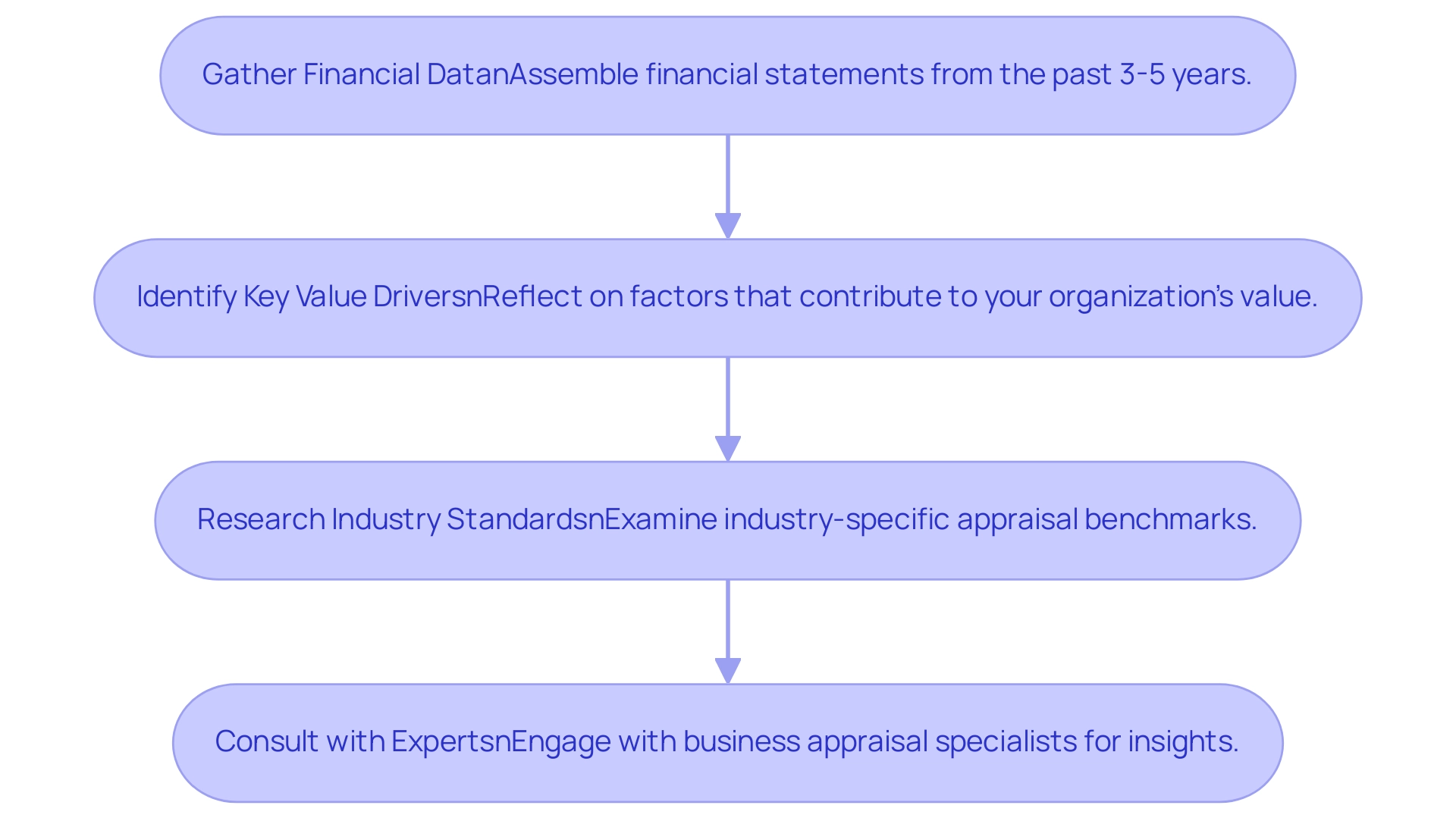
Key Valuation Methods: Approaches to Determine Business Worth
Assessing an enterprise is not just a crucial phase in the selling process; it’s a journey that can feel overwhelming. Yet, various techniques can be utilized, each tailored to the unique traits of the firm and its sector. Let’s explore some of the most common valuation methods together:
-
Asset-Based Approach: This method helps you understand a company’s value by calculating its total assets and subtracting liabilities. It’s particularly advantageous for companies rich in tangible assets like real estate or equipment. For instance, when ‘EcoPack’ was assessed, its asset-based valuation stood at $900,000, illustrating how this method can provide a clear financial picture.
-
Income Approach: Here, the focus shifts to the entity’s potential to generate future income. Techniques such as Discounted Cash Flow (DCF) analysis estimate the present value of anticipated future cash flows, while capitalization of earnings evaluates profitability in relation to its value. This method is particularly useful for organizations with predictable income streams, offering insights into what the future may hold.
-
Market Approach: This method compares a company to similar firms that have recently sold, utilizing metrics like price-to-earnings ratios or revenue multiples to establish a fair market value. This comparative analysis can provide valuable insights into how your company stands against its competitors, helping you feel more informed.
-
Seller’s Discretionary Earnings (SDE): Commonly used for small enterprises, this method calculates total earnings before interest, taxes, depreciation, and amortization (EBITDA), adding back any owner’s benefits. This approach helps potential buyers understand the true profitability of the venture from the owner’s perspective, providing clarity during the decision-making process.
Understanding these valuation methods can yield a range of values, enabling more informed investment decisions. Financial experts emphasize the importance of grasping the nuances of each method. While the asset-based method offers a strong foundation grounded in tangible assets, the income approach sheds light on future earnings potential, which can be more indicative of an entity’s long-term viability.
As Parnell Woodard, a Career Ownership Coach, wisely states, “Grasping the worth of a company is essential for individuals moving towards career ownership, as it enables them to make informed choices about their professional futures.”
Recent case studies highlight the necessity of accurate business valuations for financial reporting, especially for publicly traded companies. These assessments not only ensure adherence to accounting principles but also aid in evaluating any reductions in company value, which can greatly affect financial reports and investor views. Moreover, the latest trends in asset assessment techniques, such as the future maintainable earnings approach, concentrate on estimating a company’s future earnings potential based on industry and market data, requiring a profound understanding of the sector.
In summary, understanding these common enterprise appraisal techniques is crucial for anyone aiming to learn how to price a business for sale effectively. Each method has its strengths and can provide valuable insights into the company’s worth, ultimately guiding sellers in making informed decisions. Remember, you are not alone in this journey; we are here to support you every step of the way.
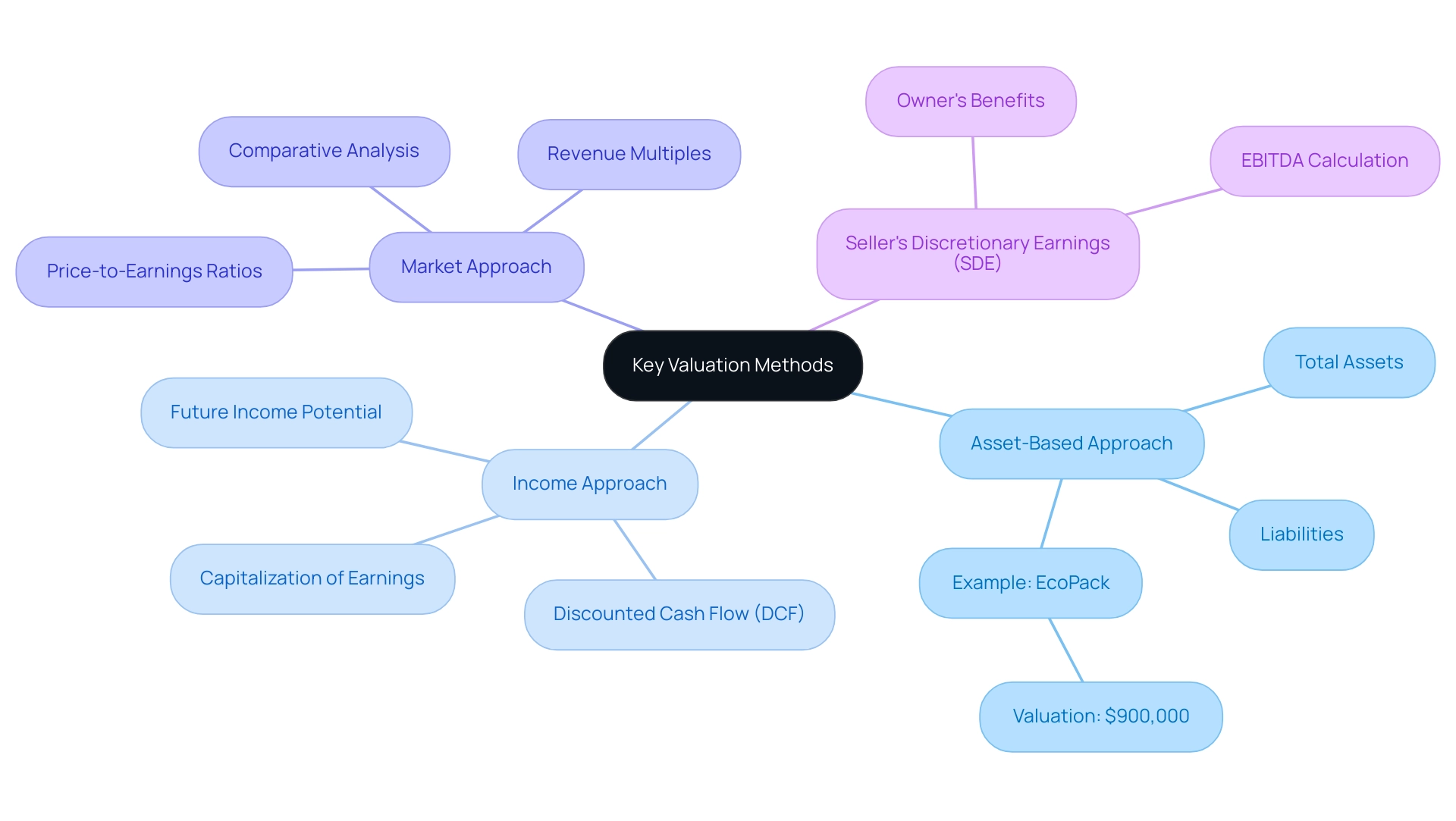
The Role of Financial Statements in Business Valuation
Financial statements are essential tools for assessing a company, providing vital insights into profitability, cash flow, and overall financial health. By effectively utilizing these documents, individuals can significantly enhance their valuation process, especially those transitioning to career ownership. As highlighted in ‘Your Career 2.0: A Survival Guide for The Battered Career Syndrome and Investor Syndrome’ by Find Your Career 2.0 | Career Ownership Coach Parnell Woodard, understanding these financial elements can empower your journey.
Utilizing Financial Statements:
- Income Statement: Have you examined revenue trends, profit margins, and operating expenses? These factors are crucial for assessing an entity’s profitability. In 2025, average profit margins vary by industry—technology sectors often report margins around 20%, while retail might hover around 5%. Knowing these benchmarks helps contextualize an organization’s performance.
Financial analysts emphasize that a thorough analysis of income statements is vital for understanding an organization’s value, especially in today’s dynamic market landscape.
-
Balance Sheet: Consider assessing assets and liabilities to determine the company’s net worth. This analysis is particularly crucial in industries where tangible assets play a significant role, such as manufacturing.
-
Cash Flow Statement: Have you scrutinized cash flow patterns? This assessment reveals the business’s ability to generate cash and sustain operations. A steady positive cash flow is a strong indicator of financial well-being, often correlating with higher multiples.
-
Normalization Adjustments: It’s important to make necessary adjustments to financial statements to reflect true operating performance. Removing non-recurring expenses or income can provide a clearer view of ongoing profitability. For instance, omitting a one-time legal settlement from the income statement can enhance your understanding of the company’s financial health.
Incorporating these elements into your assessment process not only improves accuracy but also fosters confidence among potential purchasers. The Entrepreneur’s Source, recognized as a trusted partner for those seeking to reinvent their professional lives, offers free consultations to help individuals start their journey toward career ownership. By leveraging these financial insights alongside the guidance from ‘Your Career 2.0,’ you can gain a better understanding of how to price a business for sale, ensuring you achieve optimal pricing.
Consider the real-world example of Career Ownership Coaching provided by The Entrepreneur’s Source, which has empowered clients to take control of their professional futures through personalized coaching and financial clarity. Furthermore, the recent guide titled ‘Risks and Rewards: A Guide to Understanding Social Media Influencer Income for Valuation Professionals‘ highlights contemporary issues in valuation, particularly in emerging sectors. This comprehensive approach to financial analysis emphasizes the significance of informed decision-making during transitions.
Don’t miss out on the opportunity to obtain ‘Your Career 2.0’—a must-have resource for navigating your career transition. Remember, you are not alone on this journey.
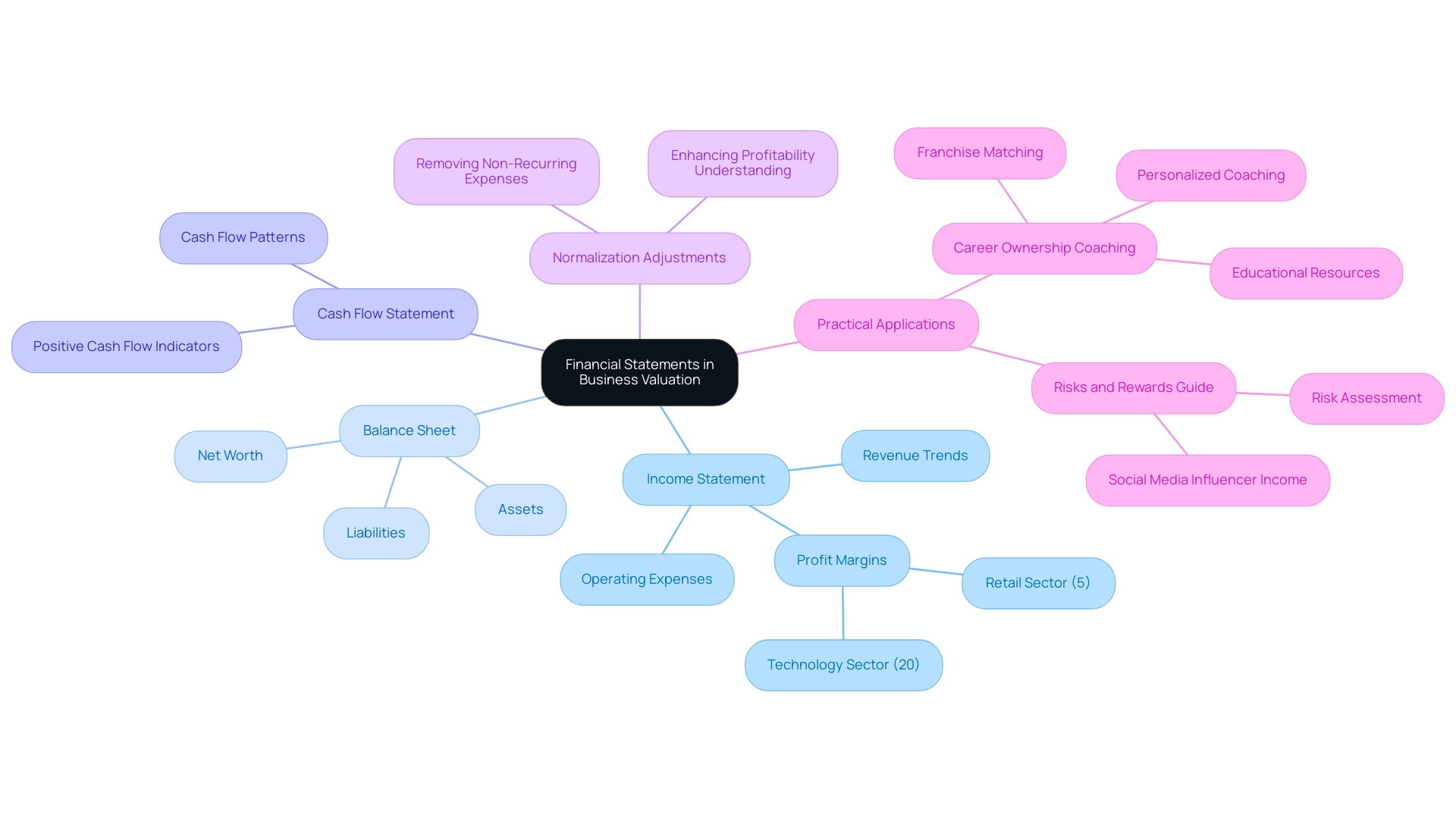
Market Research: Finding Your Business’s Place in the Market
Understanding your competitive environment and industry dynamics can feel overwhelming, but performing comprehensive industry research is a vital step towards clarity and success. Here’s a structured approach to effective research of the industry that can guide you through this process:
-
Identify Competitors: Start by compiling a list of businesses similar to yours in size, industry, and location. Take a moment to examine their cost strategies and market positioning—how do they attract and retain customers? The U.S. Chamber of Commerce reveals that the top five most profitable small enterprise industries include home improvement services, cleaning services, tutoring services, personal training and fitness instructors, and delivery services. This insight can be instrumental in guiding your cost decisions.
-
Analyze Market Trends: Staying informed about current trends impacting your industry is crucial. Consider shifts in consumer preferences, economic conditions, and technological advancements. For example, in 2025, 18% of small enterprises plan to invest in digital marketing, reflecting a growing trend towards online interaction that could influence your cost strategies. However, it’s important to acknowledge that 56% of small enterprise owners feel that digitalization is too expensive, presenting challenges in adapting to these trends.
-
Gather Customer Insights: Engaging with your customers through surveys or interviews can provide valuable insights into their perceptions of value and pricing. What are they willing to pay? Understanding this can be critical when pricing a business for sale in a competitive market.
-
Utilize Online Tools: Don’t overlook the power of online databases and research reports. These resources can help you collect data on industry benchmarks and competitor performance. Recognizing gaps in the industry and opportunities for differentiation can set you apart. For instance, a case study shows that 41% of local enterprises rely on social media to drive revenue, with 96% incorporating it into their marketing strategies. This underscores the importance of digital marketing in shaping your pricing strategies.
By following these steps, you can cultivate a comprehensive understanding of your market environment. Remember, you are not alone in this journey; with the right insights, you can make informed decisions about pricing your business for sale, ultimately leading to a more empowered and successful future.
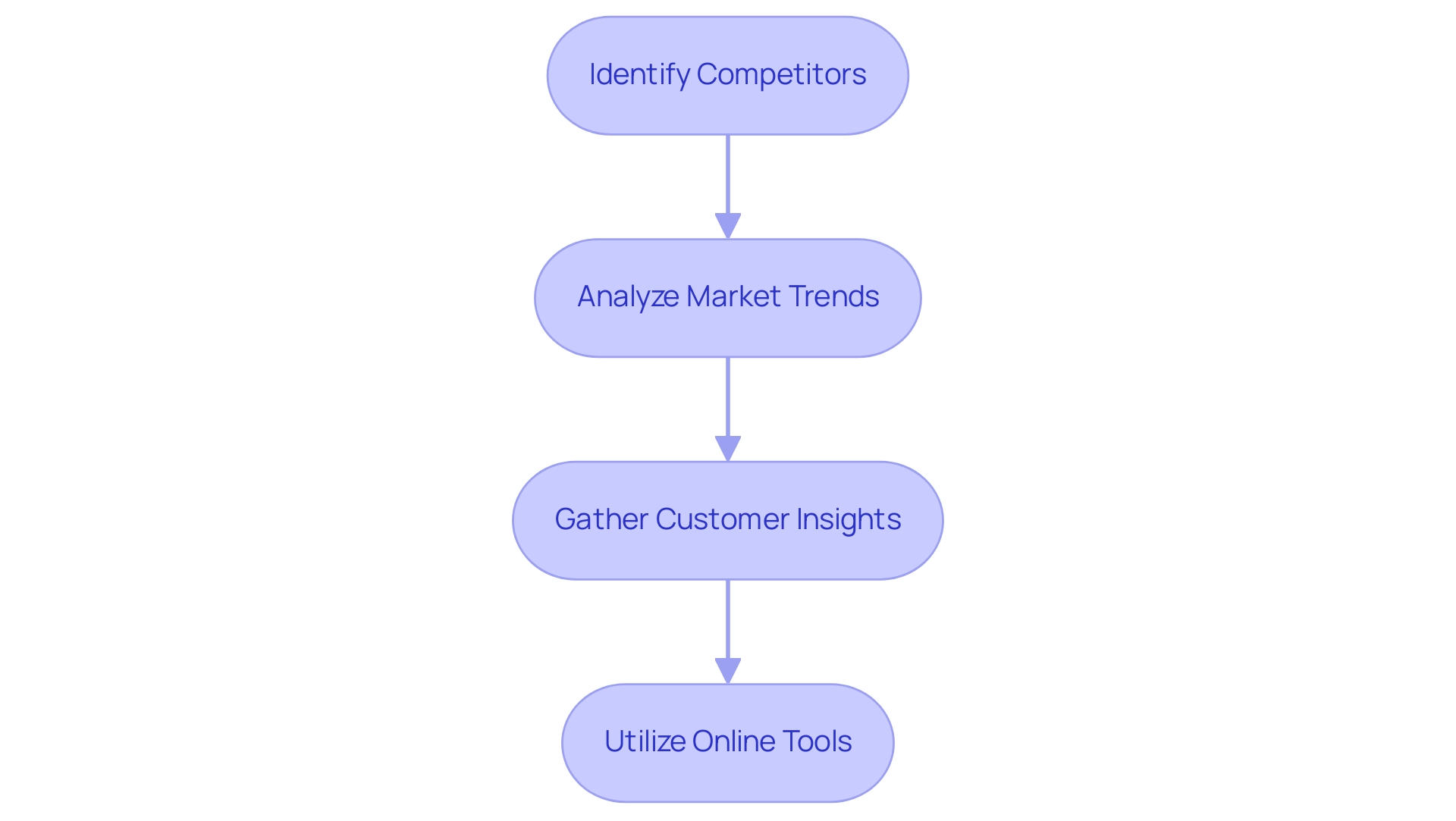
Setting the Right Price: Balancing Value and Buyer Perception
Understanding how to price a business for sale can feel overwhelming, especially when considering both its intrinsic value and the perceptions of potential buyers. You are not alone in navigating this complex process. Here are some essential strategies to help you set the right price with confidence:
-
Value-Based Pricing: Establish your price based on the perceived value to the buyer rather than merely on costs. This approach involves assessing what buyers are willing to pay, considering the unique benefits your business provides. As the market evolves, particularly with the shift towards value-based cost models, aligning your strategy with buyer expectations is crucial. For instance, CMS aims to transition Medicare to a fully value-based program by 2030, reflecting a broader trend across various industries.
-
Psychological Pricing: Have you ever noticed how a price of $99,900 feels more appealing than $100,000? This is a powerful tactic that taps into buyer psychology, making the price seem more attractive. Understanding these cognitive biases can significantly influence buyer behavior, encouraging them to see the value in your offering. As Parnell Woodard, a Career Ownership Coach, emphasizes, recognizing buyer psychology is essential in navigating industry dynamics effectively.
-
Flexibility: It’s important to remain open to adjusting your price based on feedback from the environment and buyer interest. A flexible cost strategy can lead to better negotiation outcomes, allowing you to respond effectively to market dynamics.
-
Communicate Value: Clearly articulating the unique selling points of your business is vital. This communication helps potential buyers recognize the value in your offer, making them more inclined to meet your price expectations.
-
Incorporate Data Insights: As revenue teams evolve into revenue intelligence units, integrating AI and data science can enhance your pricing strategy. Employing data analysis to understand market trends and consumer behavior can guide your pricing decisions, ensuring they align with current conditions.
-
Case Studies on Value-Based Pricing: Consider the SaaS industry, where nearly 80% of companies leverage usage data to enhance their revenue strategies. This shift towards personalization not only creates fairer pricing models but also ensures that customers pay only for what they need. It reflects a growing emphasis on value-based pricing.
By implementing these strategies, you can learn how to price your business for sale in a way that reflects its true worth and resonates with potential buyers. Remember, you have the tools to achieve a successful sale, and we’re here to support you every step of the way.
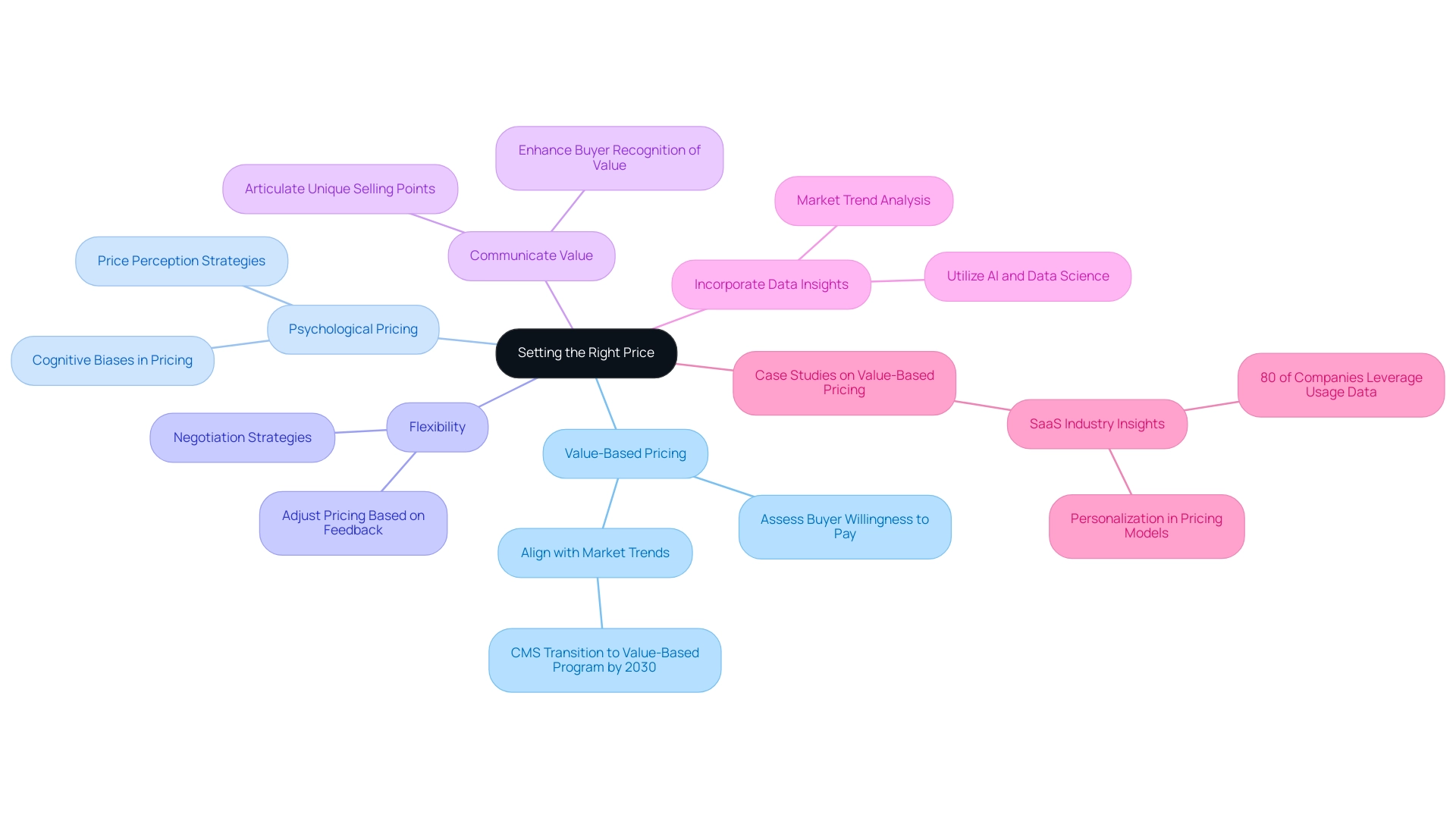
Negotiation Strategies: Preparing for Buyer Discussions
Negotiation is a pivotal phase in the sale process, and effective preparation can significantly influence the outcome. We understand that this can be a challenging time, but here’s how to prepare effectively:
- Know Your Bottom Line: Establish the minimum price you are willing to accept. Being clear about your bottom line empowers you to walk away from offers that do not meet your expectations, ensuring you do not settle for less than what you are worth.
- Understand Buyer Motivations: Conduct thorough research on potential buyers to grasp their motivations and what they value in an acquisition. Understanding these factors can help tailor your negotiation strategy to align with their interests, ultimately leading to stronger agreements.
- Practice Your Pitch: Develop a compelling narrative about your enterprise that emphasizes its strengths and growth potential. A well-articulated pitch can resonate with buyers, making them more inclined to see the value in your venture.
- Be Ready to Compromise: Identify areas where you can be flexible, such as payment terms or transition support. This willingness to adapt can facilitate a successful negotiation and foster a positive relationship with the buyer.
In 2025, statistics indicate that understanding buyer motivations is crucial, as it can significantly impact negotiation outcomes. For instance, companies that effectively communicate their value proposition and align it with buyer interests can enhance their profitability by up to 50%. This highlights the importance of anchoring negotiations in value creation, which leads to better long-term results.
Moreover, insights from negotiation experts emphasize that a negotiator with high emotional intelligence can navigate complex discussions with emotional control, resulting in mutually beneficial outcomes. As Dave DeSantis notes, “A negotiator with high emotional intelligence can effectively navigate complex discussions with emotional control, leading to more successful, mutually beneficial outcomes.” By fostering clear communication channels and maintaining transparency throughout the negotiation process, sellers can build trust and facilitate smoother transactions.
Additionally, a case study from a webinar by Imparta showed that inadequate negotiation skills can result in a 5% decrease in profits, highlighting the significance of refining these abilities, particularly for career transitioners who may be navigating new professional environments. The insights from ‘Your Career 2.0: A Survival Guide for The Battered Career Syndrome and Investor Syndrome’ emphasize the need for personal agency and transferable skills in achieving financial freedom and successful career transitions. The Entrepreneur’s Source has assisted hundreds of thousands of people in assessing their career possibilities, emphasizing the relevance of strong negotiation skills in achieving successful career transitions.
In summary, preparation is key to successful negotiations, especially when considering how to price a business for sale. By knowing your bottom line, understanding buyer motivations, practicing your pitch, and being open to compromise, you can enhance your negotiation strategy and effectively learn how to price a business for sale to achieve a favorable result.
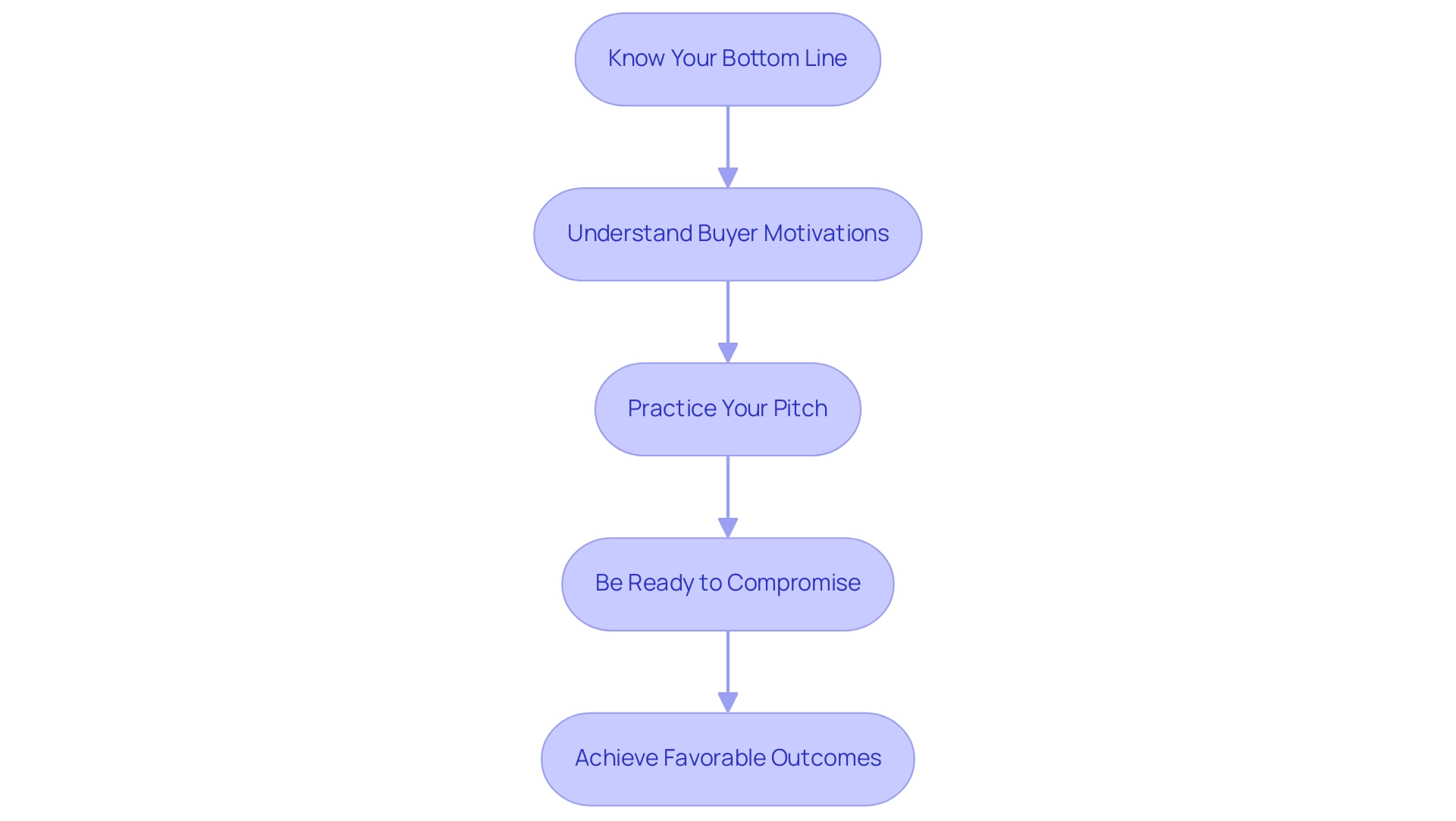
Avoiding Common Pricing Mistakes: Tips for Sellers
Steering clear of typical value-setting errors is crucial for successfully pricing a business for sale. We understand that navigating this process can be daunting, but being aware of key pitfalls can help you make informed decisions.
Common Pricing Mistakes:
-
Overpricing: Setting an unrealistic price can significantly deter potential buyers. It’s disheartening to see enterprises that are overpriced linger on the market, diminishing their appeal. In 2025, statistics indicate that companies that overprice their offerings face a notable decline in buyer interest. Reflecting current economic conditions in your pricing is essential for attracting the right buyers.
-
Ignoring Market Trends: We recognize that failing to consider prevailing market trends can lead to mispricing. For instance, in 2025, businesses that aligned their cost strategies with industry shifts experienced a notable increase in buyer interest. Staying informed about changes in your sector and understanding buyer expectations is vital for setting a competitive price.
-
Lack of Flexibility: Being inflexible with your rates can hinder negotiations. Buyers appreciate a willingness to discuss and adjust prices based on feedback. This adaptability can facilitate smoother negotiations and potentially lead to a quicker sale. Did you know that sales leaders who teach their reps to open cold calls with the question, ‘How’ve you been?’ see a 6.6% increase in success rates? This demonstrates the significance of effective communication in cost discussions.
-
Neglecting Professional Advice: Skipping expert consultation can lead to missed opportunities for precise assessment and efficient cost strategies. Hiring a broker or assessment specialist can offer essential perspectives, assisting you in steering clear of typical mistakes. Brokers emphasize knowing how to price a business for sale and often advise sellers to conduct thorough market research and seek professional valuations to avoid the pitfalls of overpricing.
-
Real-World Examples of Overpricing: Consider the case study of small enterprises, which reveals significant revenue disparities based on size. Non-employer firms average $49,489 in annual revenue, while enterprises with up to four employees average $387,000, and those with 10-19 employees average $2,164,000. This data illustrates that scaling a business typically requires hiring employees, which can lead to higher revenue generation. Overcharging in this context can alienate potential buyers who are seeking viable growth opportunities.
-
Expert Insights on Common Costing Mistakes: Business brokers emphasize the importance of realistic valuation strategies. They often advise sellers to conduct thorough market research and seek professional valuations to avoid the pitfalls of overpricing. By grasping the subtleties of costs, sellers can position their enterprises more appealingly in the marketplace, ultimately leading to a successful sale.
Additionally, B2B organizations with aligned sales and marketing operations grow revenues 24% faster and profits 27% faster over three years, underscoring the significance of strategic pricing in achieving business success. Remember, you are not alone in this journey, and with the right strategies, you can navigate the complexities of pricing with confidence.
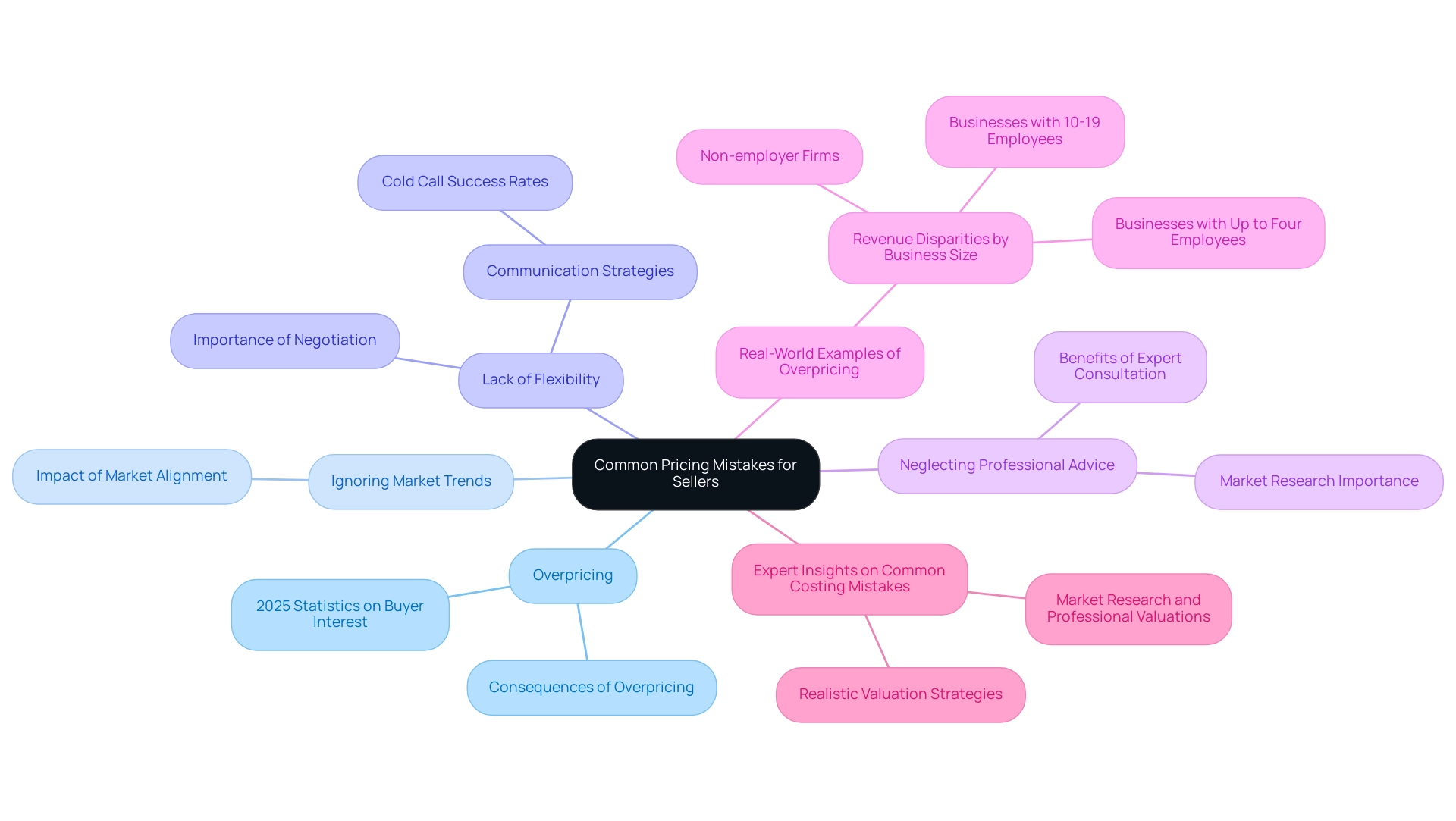
Conclusion
Understanding the complexities of business valuation is not just about numbers; it’s about your journey as a seller aiming for a successful sale. We recognize that this process can be daunting, but by gathering comprehensive financial data and recognizing vital value drivers, you can take the first steps toward clarity. Employing various valuation methods tailored to your business’s unique aspects allows you to establish a realistic and competitive asking price that truly reflects your company’s worth.
The role of financial statements is crucial—they offer critical insights into your business’s profitability, cash flow, and overall financial health. When utilized effectively, alongside thorough market research, these documents empower you to comprehend your competitive landscape and set prices that resonate with potential buyers. Moreover, implementing strategies like value-based pricing and psychological pricing techniques can enhance your business’s appeal in the eyes of buyers, making your offering even more compelling.
As we look toward the evolving landscape of 2025, it’s essential to remain vigilant about market trends and be prepared to negotiate effectively. You are not alone in this; by avoiding common pricing mistakes and seeking professional guidance when necessary, you can navigate the complexities of business valuation with confidence. Ultimately, combining informed decision-making, strategic pricing, and robust negotiation skills will empower you to achieve optimal pricing and secure a successful transaction. Remember, every step you take brings you closer to realizing your aspirations.
Frequently Asked Questions
Why is understanding company valuation important?
Understanding company valuation is crucial as it helps assess the true economic value of an organization, guiding how to price a business for sale by analyzing factors such as assets, liabilities, and future earnings potential.
What steps should I follow to value my business?
The steps to value your business include: 1. Gather Financial Data: Assemble financial statements from the past three to five years. 2. Identify Key Value Drivers: Reflect on factors that contribute to your organization’s value. 3. Research Industry Standards: Examine industry-specific appraisal benchmarks. 4. Consult with Experts: Engage with business appraisal specialists for professional insights.
What types of financial documents are essential for business valuation?
Essential financial documents include income statements, balance sheets, and cash flow statements from the past three to five years.
What are key value drivers in a business?
Key value drivers are factors that significantly contribute to an organization’s value, such as a loyal customer base, strong brand reputation, and unique selling propositions.
How can industry standards affect business valuation?
Industry standards provide benchmarks for assessing comparable enterprises, which can inform sellers about current trends and help them understand how their business stands in the market.
What are the common methods for business valuation?
Common methods for business valuation include: – Asset-Based Approach: Calculates total assets minus liabilities. – Income Approach: Focuses on potential future income, using techniques like Discounted Cash Flow (DCF) analysis. – Market Approach: Compares the company to similar firms using metrics like price-to-earnings ratios. – Seller’s Discretionary Earnings (SDE): Calculates earnings before interest, taxes, depreciation, and amortization, adding back owner’s benefits.
How does the Asset-Based Approach work?
The Asset-Based Approach determines a company’s value by calculating its total assets and subtracting its liabilities, providing a clear financial picture, especially for companies with tangible assets.
What is the Income Approach in business valuation?
The Income Approach estimates the present value of anticipated future cash flows and evaluates profitability in relation to its value, making it useful for organizations with predictable income streams.
What is the Market Approach and how does it work?
The Market Approach assesses a company by comparing it to similar firms that have recently sold, using metrics like price-to-earnings ratios or revenue multiples to establish fair market value.
What is Seller’s Discretionary Earnings (SDE)?
Seller’s Discretionary Earnings (SDE) is a valuation method for small enterprises that calculates total earnings before interest, taxes, depreciation, and amortization, adding back any owner’s benefits to clarify profitability from the owner’s perspective.
How can technology trends impact business valuation?
Technology trends, such as the rise of process automation and changing consumer behaviors, can significantly influence company worth and market potential, as seen in recent developments like the adoption of short video apps.
What role do experts play in the business valuation process?
Experts, such as business appraisal specialists, provide professional insights and guidance on valuation techniques, helping business owners navigate the complexities of assessing their company’s worth.


